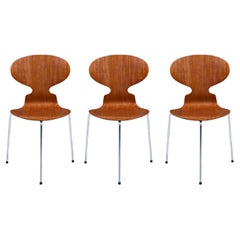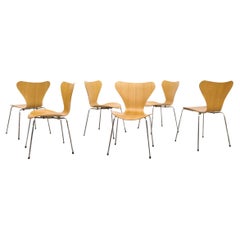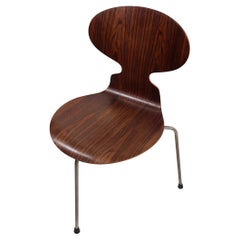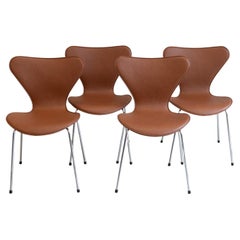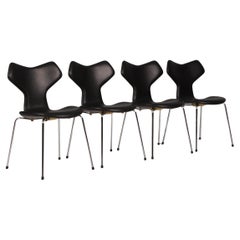Arne Jacobsen Dining Room Chairs
The eye-catching work of the Danish architect and designer Arne Jacobsen often introduces new collectors to mid-20th century furniture. With their fluid lines and sculptural presence, Jacobsen’s signature pieces — the elegant Swan chair and the cozy-yet-cutting edge Egg chair, both first presented in 1958 — are iconic representations of both the striking aesthetic of the designers of the era and their concomitant attention to practicality and comfort. Jacobsen designed furniture that had both gravitas and groove.
Though Jacobsen is a paragon of Danish modernism, his approach to design was the least “Danish” of those who are counted as his peers. The designs of Hans Wegner, Finn Juhl, Børge Mogensen and others grew out of their studies as cabinetmakers. They prized skilled craftsmanship and their primary material was carved, turned and joined wood. Jacobsen was first and foremost an architect, and while he shared his colleagues’ devotion to quality of construction, he was far more open to other materials such as metal and fiberglass.
Many of Jacobsen’s best-known pieces had their origin in architectural commissions. His molded-plywood, three-legged Ant chair (1952) was first designed for the cafeteria of a pharmaceutical company headquarters. The tall-backed Oxford chair was made for the use of dons at St. Catherine’s College, Oxford, whose Jacobsen-designed campus opened in 1962 (while still under construction). The Swan, Egg and Drop chairs and the AJ desk lamp were all created as part of Jacobsen’s plan for the SAS Royal Copenhagen Hotel, which opened in 1960. (The hotel has since been redecorated, but one guest room has been preserved with all-Jacobsen accoutrements.)
To Jacobsen’s mind, the chief merit of any design was practicality. He designed the first stainless-steel cutlery set made by the Danish silver company Georg Jensen; Jacobsen’s best-selling chair — the plywood Series 7 — was created to provide lightweight, stackable seating for modern eat-in kitchens. But as you will see from the objects on 1stDibs, style never took a backseat to function in Arne Jacobsen’s work. His work merits a place in any modern design collection.
Find authentic Arne Jacobsen chairs, tables, sofas and other furniture on 1stDibs.
1950s Danish Mid-Century Modern Vintage Arne Jacobsen Dining Room Chairs
Metal, Steel
1970s Danish Mid-Century Modern Vintage Arne Jacobsen Dining Room Chairs
Metal, Chrome
Mid-20th Century Danish Scandinavian Modern Arne Jacobsen Dining Room Chairs
Chrome
Early 2000s Danish Scandinavian Modern Arne Jacobsen Dining Room Chairs
Leather, Bentwood
1960s Danish Scandinavian Modern Vintage Arne Jacobsen Dining Room Chairs
Steel
1990s Danish Scandinavian Modern Arne Jacobsen Dining Room Chairs
Chrome
1960s Danish Scandinavian Modern Vintage Arne Jacobsen Dining Room Chairs
Steel
1960s Danish Scandinavian Modern Vintage Arne Jacobsen Dining Room Chairs
Leather
1960s Danish Scandinavian Modern Vintage Arne Jacobsen Dining Room Chairs
Leather
Mid-20th Century Danish Mid-Century Modern Arne Jacobsen Dining Room Chairs
Leather
1960s Danish Scandinavian Modern Vintage Arne Jacobsen Dining Room Chairs
Leather
Mid-20th Century Danish Mid-Century Modern Arne Jacobsen Dining Room Chairs
Teak, Plywood, Beech
1960s Danish Scandinavian Modern Vintage Arne Jacobsen Dining Room Chairs
Stainless Steel
2010s Danish Mid-Century Modern Arne Jacobsen Dining Room Chairs
Chrome
1950s Danish Mid-Century Modern Vintage Arne Jacobsen Dining Room Chairs
Chrome
1960s Danish Mid-Century Modern Vintage Arne Jacobsen Dining Room Chairs
Metal, Chrome
1960s Danish Mid-Century Modern Vintage Arne Jacobsen Dining Room Chairs
Leather
Mid-20th Century Danish Mid-Century Modern Arne Jacobsen Dining Room Chairs
Steel
1960s Danish Scandinavian Modern Vintage Arne Jacobsen Dining Room Chairs
Leather
1970s Danish Modern Vintage Arne Jacobsen Dining Room Chairs
Metal
1950s Danish Mid-Century Modern Vintage Arne Jacobsen Dining Room Chairs
Stainless Steel, Chrome
1990s Danish Modern Arne Jacobsen Dining Room Chairs
Steel
Mid-20th Century Mid-Century Modern Arne Jacobsen Dining Room Chairs
Aluminum
1960s Danish Mid-Century Modern Vintage Arne Jacobsen Dining Room Chairs
Steel
Early 2000s American Modern Arne Jacobsen Dining Room Chairs
Metal
1960s Danish Scandinavian Modern Vintage Arne Jacobsen Dining Room Chairs
Leather
1960s Danish Mid-Century Modern Vintage Arne Jacobsen Dining Room Chairs
Chrome
1950s Danish Mid-Century Modern Vintage Arne Jacobsen Dining Room Chairs
Leather, Walnut
Mid-20th Century Danish Scandinavian Modern Arne Jacobsen Dining Room Chairs
Metal
Mid-20th Century Danish Scandinavian Modern Arne Jacobsen Dining Room Chairs
Plywood, Teak
1980s Danish Mid-Century Modern Vintage Arne Jacobsen Dining Room Chairs
Chrome
1950s Danish Mid-Century Modern Vintage Arne Jacobsen Dining Room Chairs
Steel
1960s Danish Scandinavian Modern Vintage Arne Jacobsen Dining Room Chairs
Steel
1960s Danish Scandinavian Modern Vintage Arne Jacobsen Dining Room Chairs
Leather
Early 20th Century Danish Scandinavian Modern Arne Jacobsen Dining Room Chairs
Leather, Bentwood
1950s Danish Mid-Century Modern Vintage Arne Jacobsen Dining Room Chairs
Steel
1950s Danish Mid-Century Modern Vintage Arne Jacobsen Dining Room Chairs
Rosewood
Late 20th Century Danish Scandinavian Modern Arne Jacobsen Dining Room Chairs
Metal
2010s Danish Modern Arne Jacobsen Dining Room Chairs
Plastic
Mid-20th Century Danish Scandinavian Modern Arne Jacobsen Dining Room Chairs
Plywood, Teak
1990s European Mid-Century Modern Arne Jacobsen Dining Room Chairs
Metal, Steel
21st Century and Contemporary Danish Scandinavian Modern Arne Jacobsen Dining Room Chairs
Metal
1950s Danish Mid-Century Modern Vintage Arne Jacobsen Dining Room Chairs
Aluminum
1960s Danish Scandinavian Modern Vintage Arne Jacobsen Dining Room Chairs
Steel
1970s Mid-Century Modern Vintage Arne Jacobsen Dining Room Chairs
Aluminum
1950s Danish Mid-Century Modern Vintage Arne Jacobsen Dining Room Chairs
Iron
1990s Danish Scandinavian Modern Arne Jacobsen Dining Room Chairs
Lacquer
1960s Danish Scandinavian Modern Vintage Arne Jacobsen Dining Room Chairs
Chrome
1970s Danish Mid-Century Modern Vintage Arne Jacobsen Dining Room Chairs
Metal
Mid-20th Century Danish Mid-Century Modern Arne Jacobsen Dining Room Chairs
Leather
1960s Danish Scandinavian Modern Vintage Arne Jacobsen Dining Room Chairs
Leather
1950s Danish Scandinavian Modern Vintage Arne Jacobsen Dining Room Chairs
Upholstery, Oak
1960s Danish Mid-Century Modern Vintage Arne Jacobsen Dining Room Chairs
Aluminum
1960s Danish Mid-Century Modern Vintage Arne Jacobsen Dining Room Chairs
Chrome
1950s Danish Scandinavian Modern Vintage Arne Jacobsen Dining Room Chairs
Steel, Chrome
1970s Danish Mid-Century Modern Vintage Arne Jacobsen Dining Room Chairs
Leather
1960s Danish Mid-Century Modern Vintage Arne Jacobsen Dining Room Chairs
Chrome
1980s Danish Mid-Century Modern Vintage Arne Jacobsen Dining Room Chairs
Leather
21st Century and Contemporary Swedish Scandinavian Modern Arne Jacobsen Dining Room Chairs
Leather
Mid-20th Century Danish Mid-Century Modern Arne Jacobsen Dining Room Chairs
Upholstery
Arne Jacobsen dining room chairs for sale on 1stDibs.
Creators Similar to Arne Jacobsen
- Who is Arne Jacobsen?1 Answer1stDibs ExpertMarch 22, 2022Arne Jacobsen was a Danish artist and architect who lived from 1902 to 1971. His style has become synonymous with Danish modernism, and he is particularly well known for his curvy chairs that include the Series 7, the Egg and the Swan. You'll find a collection of Arne Jacobsen furniture on 1stDibs.
- What inspired Arne Jacobsen?1 Answer1stDibs ExpertMarch 22, 2022Many things inspired the work of Arne Jacobsen. The Danish designer and architect often looked to elements of nature, particularly the garden behind his home. In addition, other architects and designers like Mies van der Rohe, Le Corbusier and Walter Gropius influenced his work. Find a collection of Arne Jacobsen furniture on 1stDibs.
- 1stDibs ExpertMarch 22, 2022The American pronunciation of Arne Jacobsen is "Aarn JAY-kub-sin," but as the artist's name is Danish, it is pronounced “AR-nee YAK-ob-sen” in his native language. He was born in Copenhagen, Denmark, on February 11, 1902, and graduated from the Royal Danish Academy of Fine Arts in the city. On 1stDibs, shop a collection of Arne Jacobsen furniture.
- What did Arne Jacobsen make?1 Answer1stDibs ExpertApril 5, 2022Arne Jacobsen was a renowned furniture designer and architect who is most frequently associated with his iconic Egg Chair, although his Swan and Ant Chairs were also quite popular. His avant-garde pieces were eye-catching and a little bit shocking, but also very functional. Shop a collection of Jacobsen furniture designs from some of the world’s top sellers on 1stDibs.
- 1stDibs ExpertApril 5, 2022Arne Jacobsen clocks are now made in Denmark. They have been manufactured in a range of other countries in the past, but now have returned to production in Denmark, where the architect and furniture designer was born. Browse through a collection of Arne Jacobsen clocks from top sellers on 1stDibs.
- 1stDibs ExpertMarch 22, 2022Arne Jacobsen designed many buildings over the course of his lifetime. Some of his well-known buildings include the campus of St. Catherine’s College in Oxford, United Kingdom, and the SAS Royal Copenhagen Hotel in Copenhagen, Denmark. On 1stDibs, find a selection of Arne Jacobsen furniture.
- 1stDibs ExpertMarch 22, 2022Arne Jacobsen became famous by designing austere, minimalist buildings and producing furniture specifically to decorate them. An example is the SAS Royal Copenhagen Hotel in Copenhagen, Denmark. Not only did he design the building, he also created his well-known Drop, Egg and Swan chairs to decorate it. On 1stDibs, find a variety of Arne Jacobsen furniture.
- 1stDibs ExpertFebruary 13, 2023The original Egg chair was designed by Arne Jacobsen for the SAS Royal Hotel in Copenhagen in 1958. It was notable for its overtly organic appearance, which Jacobsen achieved with craft-based padding and upholstery finishing. With the Egg chair, Jacobsen continued his ongoing experimentation with synthetic materials. First, he devised small-scale clay models in his garage. The prototypes' finished shells were made of fiberglass-reinforced polyurethane foam, padded with cast latex foam rubber and then upholstered with leather — or, in the cost-conscious hotel’s case, fabric. Today, the Egg chair is supported by welded steel tubing and is mounted on a lightweight aluminum base. Shop a selection of vintage Egg chairs on 1stDibs.
- 1stDibs ExpertMarch 22, 2022How you set an Arne Jacobsen alarm clock depends on the model. Many of the clocks feature two knobs on the back. One sets the time, and the other controls the alarm. New clocks designed under the Arne Jacobsen name come with instructions that can guide you through the process. You'll find a range of Arne Jacobsen clocks on 1stDibs.
- 1stDibs ExpertMarch 22, 2022The bases of Arne Jacobsen chairs are mounted in different ways. In some pieces, artisans bolt or screw the base into the seat. Other designs have a pedestal base driven into a hole on the seat bottom with a mallet. On 1stDibs, shop a selection of Arne Jacobsen chairs.
- 1stDibs ExpertFebruary 17, 2023Arne Jacobsen made the Egg chair for the SAS Royal Hotel in Copenhagen, Denmark, in 1958. The curvy chair was meant to contrast with the SAS Royal Hotel’s straight lines as well as showcase Jacobsen’s eye for interiors. The Egg chair was notable for its overtly organic appearance, which Jacobsen achieved with craft-based padding and upholstery finishing. On 1stDibs, shop a selection of vintage Egg chairs.
- 1stDibs ExpertMarch 22, 2022The best way to tell if an Arne Jacobsen chair is real is to look for the label. On designs made before 2006, the label appears on the base of the chair. The designs varied over the years, but usually say "Made in Denmark by Fritzhansen." Chairs made after 2006 usually feature a sewn-on label along the fabric on the bottom of the seat. The label typically says "Republic of Fritz Hansen." Shop a collection of expertly vetted Arne Jacobsen chairs on 1stDibs.
- 1stDibs ExpertApril 5, 2024To program an Arne Jacobsen Roman table clock, remove the back of the clock and locate the two knobs found on the back of the clear case. Turn one knob to change the time and the other to set the alarm. Shop a range of vintage table clocks on 1stDibs.
- 1stDibs ExpertMarch 22, 2022Whether an Arne Jacobsen Egg chair supports the back adequately is largely a matter of personal perception. Jacobsen did design the chair's ergonomic, dramatic curves to correspond to the contours of the human body in order to deliver a comfortable seating experience. On 1stDibs, find a selection of Arne Jacobsen Egg chairs.
